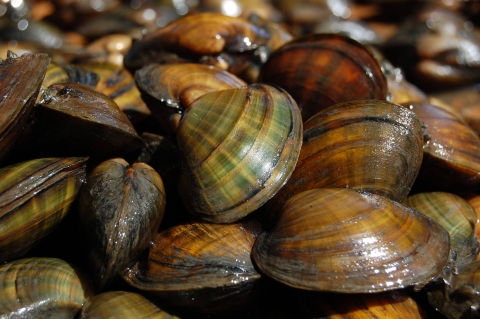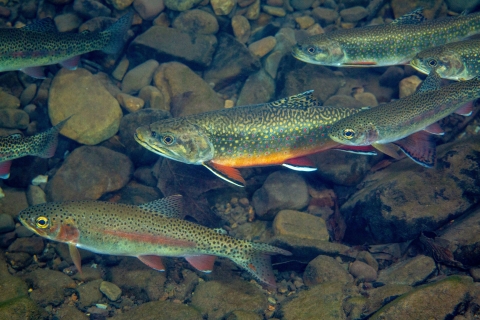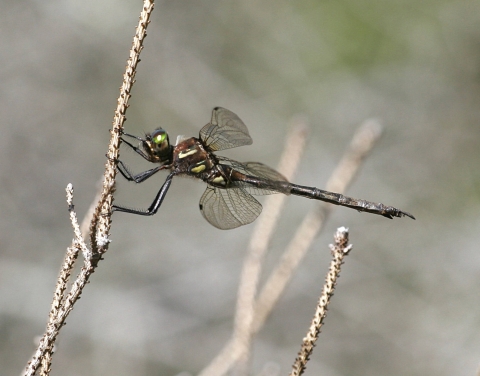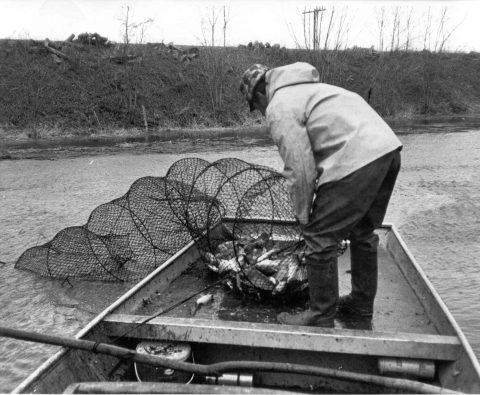Seasons of Wildlife
In the spring, you can see walleye, largemouth bass, lake sturgeon, yellow perch, rainbow trout, brook trout, freshwater mussels, mudpuppies, channel catfish and bluegill black crappie. You may also see sandhill cranes, killdeer, shorebirds and turtles in the area.
In the summer, you can see lake sturgeon propagation and tagging as well as pond harvesting of bass, perch and walleye. Freshwater mussel tagging may also be viewed.
In the fall, you can see final pond harvesting as well as migrations including many different species of waterfowl, shore birds, pelicans and bald eagles.
In the winter, you can see resident songbirds and mammals such as otter, mink and muskrats. At the hatchery you can see trout egg care, mussel host fish overwinter care and juvenile mussel culture ongoing in our mussel building.
Featured Species
Lake Sturgeon
The hatchery has grown into one of the largest culture operations for restoration lake sturgeon in the United States. A sturgeon production building allows the station to raise more than 60,000 six to eight-inch sturgeon fingerlings per year to support five ongoing restoration programs. Sturgeon fingerlings are then stocked in Missouri, Minnesota New York, Ohio and Wisconsin waters. Sturgeon eggs and fry are also shipped to other federal stations for stocking and research needs.
Endangered Mussel Recovery
The hatchery is home to one of the largest mussel culture recovery projects in North America. The Higgins eye pearly mussel has been listed under the Endangered Species Act since 1976. The hatchery produces more than 500,000 Higgins eye mussel juveniles for stocking into four river systems in the Upper Mississippi River watershed. The hatchery also propagates channel catfish and juvenile mussels for work related to the winged mapleleaf mussel recovery program. This very rare species of mussel is one of the most endangered freshwater mussels in North America.
Lake Trout Restoration
The U.S. Fish and Wildlife Service restores native fish species in the Great Lakes and has been involved in lake trout restoration since the 1950s, when fishery populations in the Great Lakes declined from overharvest, pollution, habitat destruction and the parasitic sea lamprey.
Genoa National Fish Hatchery contributes to these restoration efforts by quarantining lake trout eggs and fish for 18 months until disease-free clearance is established. These strains are used to develop captive broodstocks to be used as an egg source to plant fish in the upper Great Lakes.
Work conducted on lake trout centers primarily on the isolation and quarantine of specific strains collected in the upper Great Lakes, or Finger Lakes Region of New York. Strains are selected based on restoration goals, post stocking survival and the strain’s ability to avoid sea lamprey predation.
Coaster Brook Trout
Coasters are native brook trout that live a portion of their lives in the Great Lakes or in the ocean along the Atlantic coast of North America. They migrate up tributaries to spawn, where the young fry will grow in streams until they are about three to six inches long. Then they migrate back to the oceans or lakes to feed and grow. When mature, adult coasters return to their birth streams, usually in about three to five years.
Coasters differ from other types, or “strains,” of brook trout generally by the habitats they live in and the great size they can attain. Although 10 pound coasters have been documented, an average coaster weighs from one to four pounds.
The coaster strain of the brook trout became a high priority for restoration during the past decade. Genoa National Fish Hatchery has been involved with all aspects of the captive propagation of this species, including brood stock collection and creation of isolation facilities which allow wild fish eggs to be quarantined and tested for fish diseases before transfer to Service hatcheries. The hatchery raises 50,000 coasters each year to support restoration programs in Minnesota. The hatchery serves as a backup facility to safeguard strains of coaster that have been collected at Isle Royale National Park.
Hines Emerald Dragonfly
In addition to raising fish and freshwater mussels, the hatchery also rears the endangered Hine’s emerald dragonfly. Historically, this dragonfly was found in Alabama, Indiana and Ohio. Present day, however, it survives in only small, isolated locations in Wisconsin, Minnesota, Illinois and Missouri. Habitat loss, pesticide use and changes in ground water have all contributed to its decline. The hatchery captively rears Hine’s emerald dragonfly adults from field-collected eggs or early larval stages in order to augment the wild Illinois populations.
Recreational Fishing and Sport Fish Restoration
The hatchery raises more than 10 species of fish to contribute to sport fish restorations in tribal, federal and state waters. Species include walleye, largemouth bass, smallmouth bass, brook trout, rainbow trout, yellow perch, sauger, black crappie and bluegill.
Genoa National Fish Hatchery is one of the few federal hatcheries that still collect wild spawning fish in spring netting operations. During March and April, hatchery crews set between 40 and 50 hoop and fyke nets to collect ripe and spawning females and males. The nets are checked daily until spring spawning runs end in early May. The eggs are removed from ripe fish, called spawning, and the fish are release unharmed to the river. The eggs are then taken back to the hatchery to begin their rearing process. In an average year, 10 to 20 million eggs will be taken for ongoing management activities and stocking programs across the midwest.





